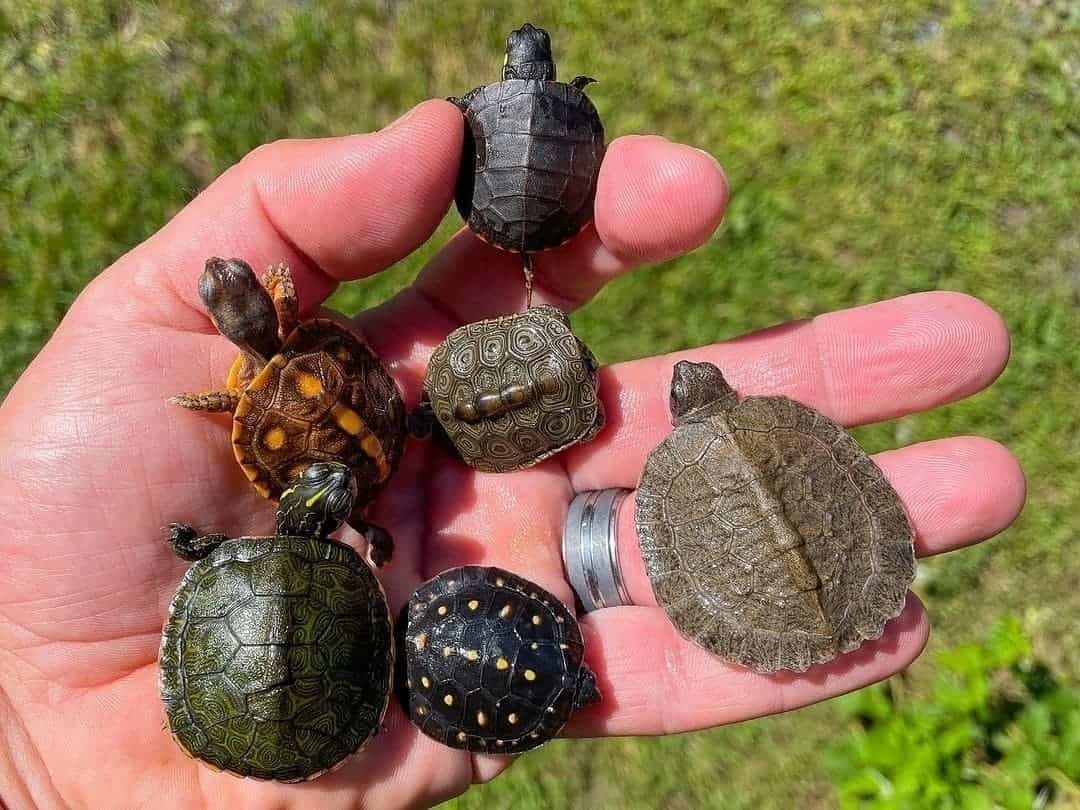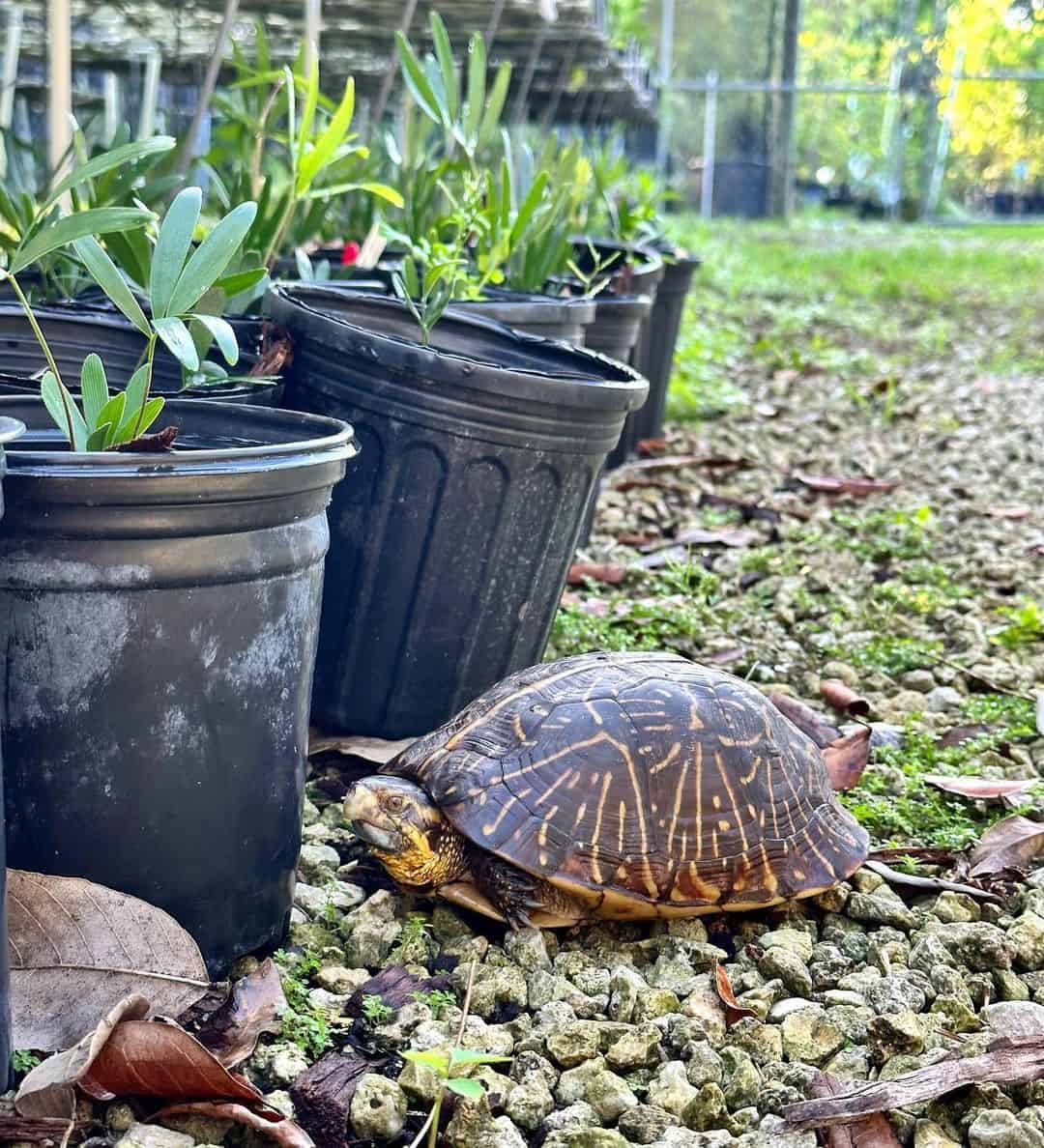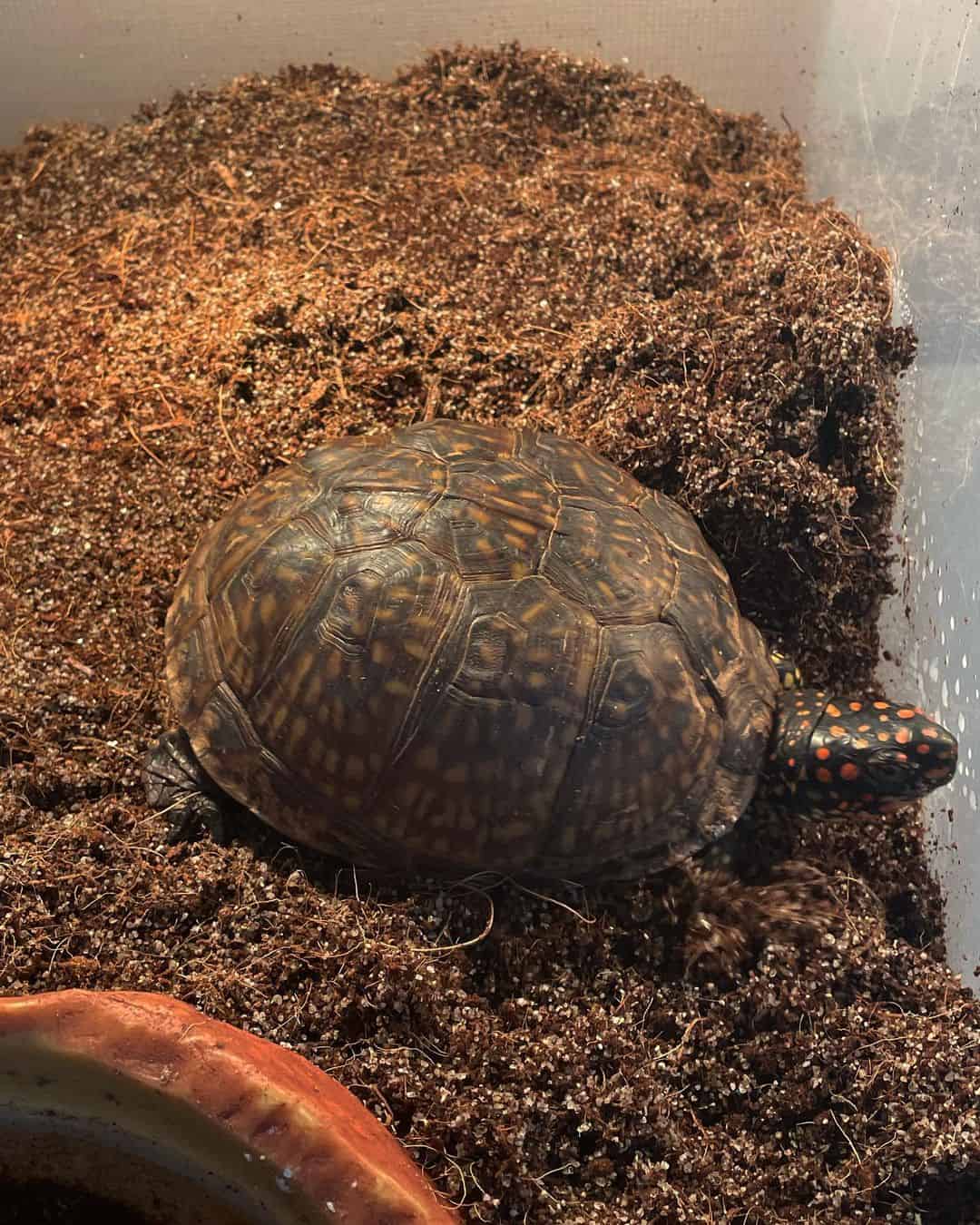Box turtles (Terrapene carolina carolina) are fascinating creatures that make wonderful pets. These small, land-dwelling reptiles are known for their unique appearance and gentle demeanor. However, like any pet, box turtles require a certain level of care to thrive.
In this article, we’ll cover everything you need to know about how to take care of a box turtle, from its habitat to its nutrition, wellness, and socialization.
Housing and Habitat
1. Environment
Box turtles, or box tortoises, require a specific environment to thrive. They need a large, secure enclosure with plenty of space to move around. It’s recommended to use glass terrariums or plastic cages for housing box turtles, as they can retain moisture without rotting.
Wooden enclosures should be avoided, while plastic storage bins with dark or opaque sides can be used to reduce stress.
Hatchlings can be housed in a 10-gallon terrarium, but as they mature, they need more space to move around and exercise, so the tank size should be increased gradually.
2. Temperature
The enclosure should be kept at a temperature range of 70 to 90°F (21-32°C) with natural sunlight or 5% UVA/UVB lighting for vitamin D. Box turtles need a warm basking area with a 75 100-watt heat lamp, which should be placed at above 18 inches from the substrate. It doesn’t necessarily mean the enclosure must always maintain the same temperature. There should be a warm and cool side in their habitat for balance.
Maintain a 12 to 14-hour light and 10 to 12-hour dark cycle. Use a separate timer for the basking bulb, which should turn on and off 15 to 20 minutes before and after overhead lights to create a simulated dawn and dusk effect inside the enclosure.
Lastly, remember to wash the tank every 2 to 3 weeks. For this, you should have an extra safe space to put your box turtle while you’re cleaning its home.
3. Enclosure Size
A box turtle enclosure should be at least 36 inches long and 12 inches wide for a single adult turtle. You don’t want to lose your pet in the middle of the night, so ensure that the enclosure has high walls and a secure lid so they cannot escape. If you plan on keeping multiple turtles, you’ll need an even larger enclosure, about 48 inches long and 15 inches tall. This can change depending on the age and size of each turtle.
Different types of box turtles have varying adult sizes. Eastern box turtles and three-toed box turtles typically reach an adult size of 4.5 to 6 inches, with the largest recorded specimens being 7 13/16 inches and 6.5 inches, respectively.
Gulf Coast box turtles grow to 5 to 7 inches; the largest recorded specimen is 8 ½ inches.
Female ornate box turtles are generally larger than males. But ornate box turtles are the smallest of the four types, with hatchlings measuring just an inch and reaching a maximum size of 4 to 5 inches.

Nutrition
In the wild, box turtles are omnivores, consuming various foods, from insects to fruits, vegetables, and dark leafy greens. Hatchlings tend to be carnivorous but will soon learn to be omnivorous as they mature.
To feed a box turtle properly, it’s best to offer food during the mornings and early afternoons when they’re most active and warm. The frequency and quantity of feeding depends on the turtle’s age, with adult turtles needing meals at least three times per week and juvenile turtles requiring daily feeding along with vitamin and calcium supplements at least thrice a week.
Ensure each turtle has different plates if you have multiple of them to avoid competition. The feeding session should include a variety of foods mentioned above. Uneaten portions, except for live food such as insects, should be removed after 15 to 20 minutes. If your turtle hibernates during its dormant months, provide water but no food. As for shy box turtles, you can feed them inside their hiding spot.
Food
According to the VCA Hospitals, box turtles need a balanced diet of 50% plants and 50% animal food. They should be rich in protein and calcium from vegetables like:
- spinach
- broccoli
- mustard greens
- kale
- collard greens
- tomatoes
- sweet potatoes
- lettuce
- carrots
- turnip greens
- beet greens
For fruits, you can supplement them with the following:
- mangoes
- spinach
- peaches
- cantaloupes
- romaine
- raspberries
- blackberries
- grapes
- apples
- strawberries
- oranges
- squash
- apricots
- dates
And for animal-based materials, their diet includes:
- grasshoppers
- mealworms
- worms
- snails
- slugs
- earthworms
- crickets
- moths
- hard-boiled eggs

Clean water
Box turtles need access to clean water at all times. Use a shallow water dish that is difficult to tip over with a ramp to allow easy access but not so deep that they could drown. The water level should reach the turtle’s chin and be changed daily to prevent bacteria from growing due to turtles eliminating or defecating in it. Misting the turtle with a water sprayer or automatic fogger a few times a week can also keep it hydrated.
However, according to the Centers for Disease Control and Prevention, box turtles carry Salmonella bacteria that can be transmitted to humans. Therefore, always remember to wash your hands thoroughly after taking care of your box turtle, play with them safely, and don’t release them outside.
Health and Wellness
Box turtles are prone to certain health issues, such as respiratory infections, ulcers, hypovitaminosis, and internal parasites. It’s important to regularly monitor the reptiles’ health to ensure they are thriving.
Signs of a box turtle in good health include:
- clear eyes
- smooth shell without spots of bruises or wounds
- no signs of dryness
- feels heavy
- retracts head and limbs when picked up as a defensive stance
You can closely detect illness symptoms if your box turtle has the following:
- shells (scutes) rot, peel, or crack
- swollen, closed, or watery eyes
- red spots or dry skin
- insects on the skin
- frequent thirst
- ear abscess
- weight loss
- changes in behavior
To ensure the health of your box turtle, it’s important to find a reptile vet nearby and schedule an initial veterinary appointment within two days of getting the turtle. This first visit may include blood and fecal tests to detect any illness. Even if your pet seems healthy, scheduling a yearly vet checkup is recommended to maintain its well-being.

Except for an unbalanced diet, these illnesses can be caused by poor living conditions. Your doctor may ask you to keep an eye on their habitat. Box turtles spend time buried in a substrate in the wild for temperature regulation and predator avoidance.
In captivity, lack of burrowing opportunities can stress them, and dry substrate can lead to health problems. The substrate’s moisture content is critical to them, so the relative humidity level should be around 80%. They need a loose, non-abrasive, and moisture-retaining substrate free of chemical additives.
Inexpensive substrates like sphagnum moss, finely shredded hardwood mulch or high-quality loam compost work well. Substrates to avoid include rough hardwood mulch, corn cob litter, and all pine, fir, and cedar mulches/shavings.
Handling and Enrichment
Box turtles are gentle creatures, but handling them safely is important to prevent injury. To safely pick up a turtle, use both hands to hold the shell between its front and back legs. Avoid using just one hand and grabbing them by their limbs or tail.
Just place your fingers under the bottom shell (plastron) and your thumbs on the top shell (carapace). But be careful with larger turtles; they can scratch you and escape if they gain momentum on your arms.
Box turtles are intelligent animals that benefit from mental and physical stimulation. According to the Reptile Guide, you can provide enrichment and entertainment by adding large rocks, caves, logs, substrate, and plants to your habitat.
You can get inspiration for their cage designs by looking at their natural habitats like ponds, fields, and woodlands. Also, like most reptiles, turtles love to dig in the sand, but as a pet parent, be cautious as they may consume it.
On Socialization and Keeping Multiple Turtles
Box turtles can live alone and don’t need companionship, but they can coexist peacefully in captivity. However, not all turtles will get along, and it’s important to be prepared to separate them if necessary. Young turtles of similar size and temperament can usually be housed together, but young males may become aggressive as they mature and should be monitored closely.
Adult female turtles usually have a good relationship with each other, but it’s a different case with adult male turtles, which are aggressive towards each other, especially during mating. They may even try to mate with other males, causing potential harm.
If housing them together, it is best to have several females for each male, with a suggested ratio of 1:4, according to the Box Turtle World website.

Adult males and females should be separated, except when breeding. You should also provide hiding spots and resources in their habitat for the female to escape an aggressive male. Besides, hygiene problems can arise if there are too many turtles in too small a space.
For added information, box turtles’ name is their unique ability to fully shut their shell, resembling a box, setting them apart from most turtles. Their underbelly has a hinge that enables them to seal it so securely that not even the tiniest ant could enter.
Forestry and Natural Resources said this feature is believed to have developed over time as a defense mechanism against natural box turtle predators.
FAQs:
Q1: Can I keep different species of turtles together?
According to an article from Pets on Mom, keeping different types of turtles together in the same tank is not recommended for various reasons. Different species of turtles may carry diseases that are not harmful to one species but could be deadly to another. Turtles have varying food and climate needs that differ among species, and some species can be more aggressive than others.
Even the same species of turtles may exhibit territorial behavior and aggression when placed together. Consulting a herpetological veterinarian before putting turtles together in the same enclosure is important.
Q2: How do you introduce new turtles to each other?
A: To introduce turtles, start in a neutral area (like the floor) to distract them and repeat the process over a day or two. Feed new and established turtles the same food separately to reduce their interest in each other’s smell.
After they’re ready, place them together and monitor their behavior. Note that it’s unnecessary to introduce baby turtles of similar ages and sizes to each other as they are typically not territorial like grown-up box turtles.
Q3: Can I keep a box turtle I found?
A: Keeping wild turtles as pets is strongly discouraged to ensure the survival of turtles, as their small habitats must be safeguarded. Instead, consider adopting one. You cannot only provide a safe and loving home to them but also help contribute to the preservation of their natural habitats.
Q4: How long does a box turtle live?
A: Box turtles can live for a very long time. In the wild, if they survive predators, they typically live for around 50 years, but some have been known to live for more than 100 years. In captivity, they can live even longer, with some living for up to 20 to 30 years or more, depending on how well they have been taken care of.
Q5: How long can a box turtle go without water?
A: Box turtles need water for drinking and wading and cannot survive without it for more than 12-24 hours. Even though they can live on land, water is necessary for hydration and body regulation. Regardless of age, box turtles become weaker the longer they spend outside the water.
Conclusion
Box turtles are wonderful pets that can provide years of companionship and joy. Following the tips outlined in this article, you can ensure your turtle is happy, healthy, and thriving in their environment. Always provide a suitable habitat, a balanced diet, and regular veterinary care to keep your turtle in the best possible health.
Do you have any other tips on how to take care of a box turtle? Share your thoughts in the comment section below!
